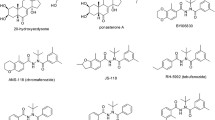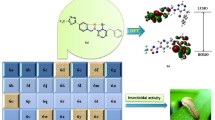Abstract
Molecular descriptors (including quantum chemical, topological and physicochemical descriptors) were calculated for five m-tolyl derivatives insecticides [namely, carbosulfan (CBS), carbofuran (CBF), isoprocab (IFP), methiocarb (MTC) and isocarbophos (ICP)]. Calculated quantum chemical parameters included the total energy, the electronic energy, the binding energy, the core–core repulsion energy, the heat of formation, the dipole moment and the frontier molecular orbital energies. All the calculated quantum chemical parameters (except dipole moment) exhibited strong correlation with the experimental LD50 values of the studied insecticides (at various Hamiltonians). Calculated topological parameters included the molecular topological index (MTI), polar surface area (PSA), total connectivity (TC), total valence connectivity (TVC), Wiener index (WI), topological diameter (TD) and Balaban index (BI). However, only MTI, PSA, WI and BI exhibited excellent correlation with the toxicological activity of the insecticides. Also among all the calculated physicochemical parameters [logP, surface area (SA), surface volume (SV), hydration energy (EHydr), polarizability (PLZ) and refractivity (RFT)], only SV, EHydr, PLZ and RFT were useful in establishing quantitative structure activity relationship (QSAR). Application of QSAR indicated that the calculated theoretical LD50 values for the studied insecticides displayed excellent correlation with experimentally derived LD50 values. However, best results were obtained from quantum chemical descriptors under modified neglect of atomic overlap (MNDO). The toxicity profile of the insecticides also correlated strongly with ionization energy, electron affinity, global softness and global harness. Reactive sites of each of the insecticides were established using Fukui function, Huckel charges and HOMO/LUMO diagrams. Six new molecules were proposed and their theoretical activities were estimated. The proposed molecules included 2-methyl-2-(methylthio)-2,3-dihydrobenzofuran-7-yl methylcarbamate, O-methyl O-2-((methylaminooxy)carbonyl)phenyl phosphoramidothioate, 2-((methylaminooxy)carbonyl)phenyl methylcarbamate, 2-(1-(methylthio)ethyl)phenyl methylcarbamate, N-methyl-O-(2-(methylthiooxy) benzoyl) hydroxyl amine and 4-methyl naphthalen-2-yl methylcarbamate. Some of the proposed molecules exhibited negative values of LD50 (indicating extreme toxicity) while two of them exhibited values that are comparable to existing insecticides.







Similar content being viewed by others
References
Ameh PO, Eddy NO (2016) Theoretical and experimental studies on the corrosion inhibition potentials of 3-nitrobenzoic acid for mild steel in 0.1 M H2SO4. Cogent Chem 2:1253904
Barbosa S, Hastings MI (2012) The importance of modelling the spread of insecticide resistance in a heterogeneous environment: the example of adding synergists to bed nets. Malar J. https://doi.org/10.1186/1475-2875-11-258
Borget F, Chiavassa T, Allouche A, Aycard JP (2001) Experimental and quantum study of adsorption of ozone on amorphous water ice film. J Phys Chem B 105(2):449–454
Can A (2014) Toxicol Lett. https://doi.org/10.1016/j.toxlet.2014.08.016
Eddy NO (2010) Theoretical study on some amino acids and their potential activity as corrosion inhibitors for mild steel in HCl. Mol Simul 35(5):354–363
Eddy NO (2011) Experimental and theoretical studies on some amino acids and their potential activity as inhibitors for the corrosion of mild steel, Part 2. J Adv Res 2:35–47
Eddy NO, Ita BI (2011a) Experimental and theoretical studies on the inhibition potentials of some derivatives of cyclopenta-1,3-diene for the corrosion of mild steel in HCl solutions. Int J Quantum Chem 111(14):3456–3473
Eddy NO, Ita BI (2011b) Theoretical and experimental studies on the inhibition potentials of aromatic oxaldehydes for the corrosion of mild steel in 0.1 M HCl. J Mol Model 17:633–647
Eddy NO, Momoh-Yahaya H, Oguzie EE (2015) Theoretical and experimental studies on the corrosion inhibition potentials of some purines for aluminum in 0.1 M HCl. J Adv Res 6:203–216
Gao W, Wang W, Farahani R (2016) Topological indices study of molecular structure in anticancer drugs. J Chem. https://doi.org/10.1155/2016/3216327
Garcia GC, Ruiz IL, Gomez-Nieto MA (2005) From Wiener index to molecules. Chem Inform Mod 45(2):231–238
Gomez-Jeria JS, Ojeda-Vergara M, Donoso-Espinoza C (1995) Quantum chemical structure activity relationship in carbamat e insecticides. Mol Eng 5(4):391–401
Husarova V, Ostatnikova D (2013) Monosodium glutamate toxic effects and their implication for human intake: a review. JMED Res. https://doi.org/10.5171/2013.608765
Iwamura H, Nishimura K, Fujita T (1985) Quantitative structure-activity relationships of insecticides and plant growth regulators: comparative studies toward understanding the molecular mechanism of action. Environ Health Perspect 61:307–320
Jian L, Yanging G, Shibin S, Xiaoping R, Jie S, Zongde W (2014) Synthesis and quantitative structure-activity relationship (QSAR) studies of novel rosin-based diamide insecticides. RSC Adv 4:58190–58199
Karabunarliev S, Mekenyan OG, Karcher W, Russom CL, Bradbury SP (1996) Quantum-chemical Descriptors for Estimating the Acute Toxicity of Substituted Benzenes to the Guppy (Poecilia reticulata) and Fathead Minnow (Pimephales promelas). Mol Inform 15(4):311–320
Kard B, Shelton K, Luper C (2014) Toxicity of pesticides Pesticide applicator certification series. Oklahoma cooperation extension services EPP-7457-8. Available from: http://pods.dasnr.okstate.edu/docushare/dsweb/Get/Document-3591/EPP-7457web.pdf
Kier LB, Hall LH (2002) The meaning of molecular connectivity: a bimolecular accessibility model. Croat Chem Acta 75(2):371–382
Lorenz ES (2006) Pesticide safety fact sheel: toxicity of pesticide. Pennsylvania University, Philadelphia
Musa AY, Jalgham RTT, Mohamad AB (2012) Molecular dynamic and quantum chemical calculations for phthalazine derivatives as corrosion inhibitors for mild steel in 1 M HCl. Corros Sci 56:176–183
Naik PK, Singh T, Singh H (2009) Quantitative structure-activity relationship (QSAR) for insecticides: development of predictive in vivo insecticide activity models. SAR/QSAR Environ Res 20(5–6):551–556
Naik PK, Alam A, Malhotra A, Rizvi O (2010) Molecular modeling and structure-activity relationship of podophyllotoxin and its congeners. J Biomol Screen 15(5):528–540
Nikolić S, Trinajstić N, Mihadlid Z (1993) Molecular topological index: an extension to heterosystems. J Math Chem 12(1):251–264
Pandith AH, Giri S, Chattaraj PK (2010) A comparative study of two quantum chemical descriptors in predicting toxicity of aliphatic compounds towards tetrahymena pyriformis. Org Chem Int. https://doi.org/10.1155/2010/545087
Prasanna S, Doerksen RJ (2009) Topological polar surface area: a useful descriptor in 2D-QSAR. Curr Med Chem 16(1):21–41
Schaftenaa G, de Vilieg J (2012) Quantum mechanical polar surface area. J Comput Aided Des 26(3):311–318
Tanii H (1994) Structure-activity relationships of organic solvents and related chemicals. Sangyo Igaku 36(5):299–313
Todeschini R, Consonni V (2000) Handbook of molecular descriptors. Methods and principles in medicinal chemistry, vol 11. Wiley, New York
Usha T, Tripathi P, Pande V, Middha SK (2013) Molecular docking and quantum mechanical studies on pelargonidin-3-glucoside as renoprotective ACE inhibitor. Comput Biol. https://doi.org/10.1155/2013/428378
Vikas R (2015) Exploring the role of quantum chemical descriptors in modeling acute toxicity of diverse chemicals to Daphnia magna. J Mol Graph Mod 61:89–101
Author information
Authors and Affiliations
Corresponding author
Rights and permissions
About this article
Cite this article
Eddy, N.O., Essien, N.B. Computational chemistry study of toxicity of some m-tolyl acetate derivatives insecticides and molecular design of structurally related products. In Silico Pharmacol. 5, 14 (2017). https://doi.org/10.1007/s40203-017-0036-y
Received:
Accepted:
Published:
DOI: https://doi.org/10.1007/s40203-017-0036-y




